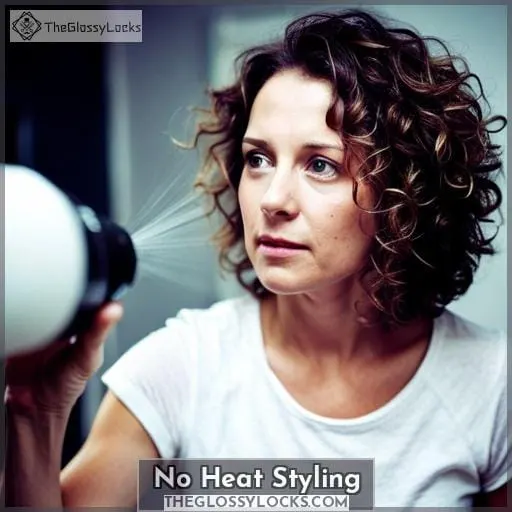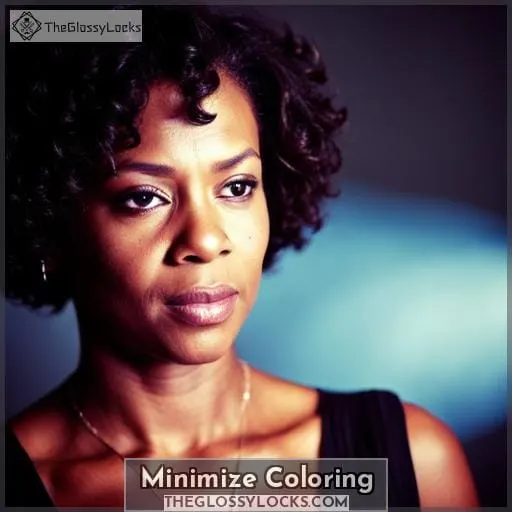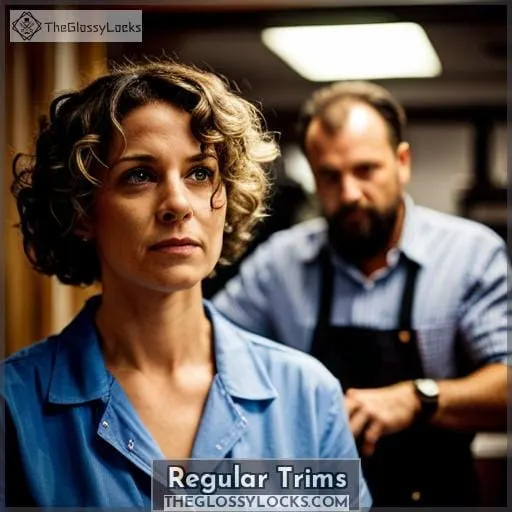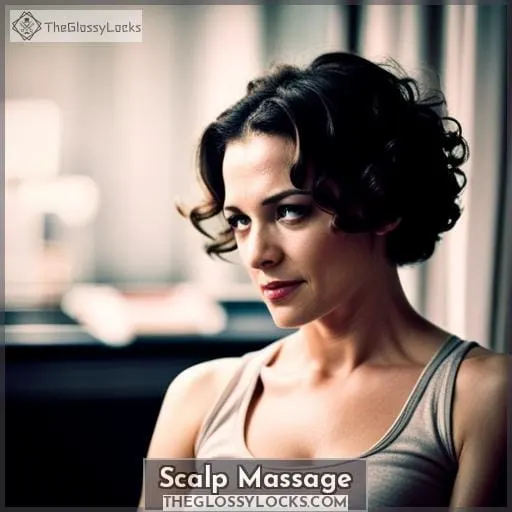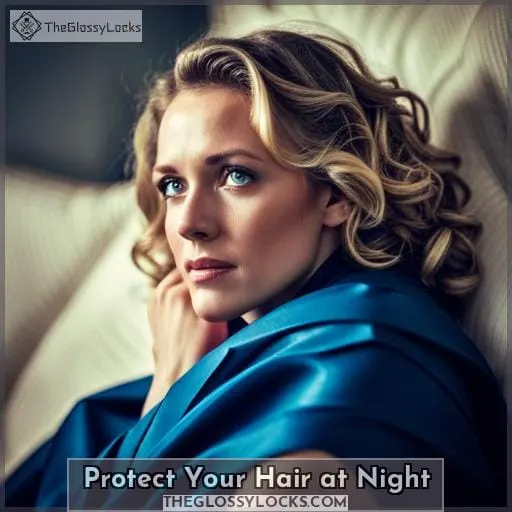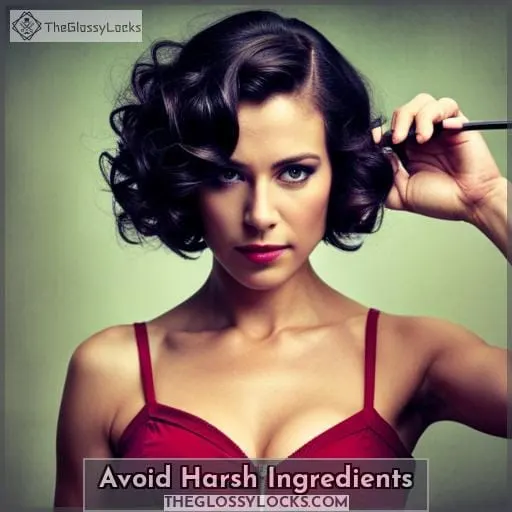This site is supported by our readers. We may earn a commission, at no cost to you, if you purchase through links.
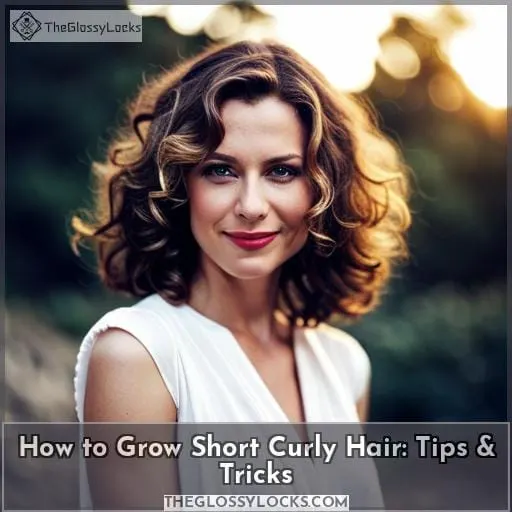
With these expert techniques, you’ll learn how to:
- Minimize heat styling
- Avoid harsh ingredients
- Hydrate your hair for optimal growth
Say goodbye to frizz and hello to healthy curls that are sure to turn heads. Get ready for a journey of self-expression as you embrace the freedom of growing out your short curly hair!
Table Of Contents
- Key Takeaways
- No Heat Styling
- Minimize Coloring
- Regular Trims
- Scalp Massage
- Hydrate Your Hair
- Protect Your Hair at Night
- Find a Curly Hair Specialist
- Avoid Harsh Ingredients
- Frequently Asked Questions (FAQs)
- Can I use heat styling tools occasionally while growing out my short curly hair?
- Is it okay to color my hair if I’m trying to grow it out?
- How often should I get trims while growing out my short curly hair?
- Does scalp massage really help with hair growth?
- What are some harsh ingredients commonly found in hair products that I should avoid while growing out my short curly hair?
- Conclusion
Key Takeaways
- Avoid heat styling and let hair air dry to prevent damage as it grows out
- Minimize coloring treatments; choose gentle, subtle options if coloring
- Get regular trims every 8 to 12 weeks for healthy growth
- Deep condition weekly to nourish and strengthen curls
No Heat Styling
To grow your short curly hair, it’s important to avoid using heat styling tools as much as possible.
Heat can damage your hair and hinder its growth.
Instead, opt for air drying or use a diffuser when blow drying, and always remember to apply a heat protectant product before using any kind of heat on your curls.
Avoiding Heat Styling Tools
To grow out your short curly hair, you should steer clear of heat styling tools like curling irons, straighteners, and blow dryers.
These tools can damage hair and cause breakage, making growth difficult.
Instead, air dry your curls or use a diffuser on cool settings.
When drying, wrap hair in a silk scarf or satin bonnet to prevent over-drying.
Completely avoiding heat will help your curls retain moisture and length as they grow out.
Using Heat Protectant Products
When having to use heat, protect your hair by applying a heat protectant spray or serum before styling.
- Apply to damp or dry hair before using any hot tools
- Evenly distribute through hair, focusing on the ends
- Allow product to fully dry before applying heat
- Reapply as needed throughout the styling process
Minimize Coloring
To minimize coloring damage and promote healthy hair growth, it’s important to choose gentle, natural colors when dyeing your short curly hair.
Avoid bleaching or highlighting as these processes can weaken the hair shaft and make it more prone to breakage.
By being mindful of the products you use on your hair, you can help maintain its strength and ensure optimal growth.
Choosing Gentle, Natural Colors
By choosing gentle, all-natural hair colors instead of harsh chemical dyes, you’ll maintain the integrity of your curls as you grow them out.
Opt for semi-permanent colors over box dye to avoid damage, and consult a stylist before applying color to find a natural shade that complements your complexion.
Test any new color on a small strand first since curly hair doesn’t always take color evenly.
Stick to subtle, natural-looking changes rather than expecting a dramatic shift in tone.
Being cautious with hair color application keeps curls healthy as you grow them out.
Avoiding Bleaching and Highlighting
You shouldn’t bleach or highlight your hair when growing out short curls, as that can severely damage the hair shaft and cause increased breakage.
When you must color, use a gentle bleach formula and avoid frequent highlights that require repeated processing.
Also be vigilant about caring for colored hair by using a color-safe shampoo, deep conditioning treatments to add moisture, and regular trims to snip away any dry, damaged ends before they travel up the hair shaft causing more harm.
Focusing on gentle hair care will help your curls grow out healthy.
Regular Trims
Get regular trims so your stylist can snip your split ends. The trims will help maintain healthy hair and promote stronger growth.
- Avoid over-trimming or cutting off too much length. You want to retain as much growth as possible while preventing breakage.
- Trims every 8-12 weeks can help stimulate your scalp and strengthen hair roots as they grow out from your pixie cut.
- Proper trims will remove splits and allow your curls to continue flourishing to new lengths.
- Let your stylist assess your hair health and determine the right trimming frequency for you.
The small snips along the way support your hair’s journey to increased length. With a careful trimming schedule, you’ll better grow out your short locks while keeping your style polished.
Scalp Massage
Stimulating your follicles through regular scalp massaging promotes healthy hair growth. Massaging your scalp helps to increase blood flow to the hair follicles, delivering essential nutrients and oxygen for optimal growth.
Here are some techniques you can try during a scalp massage:
| Technique | How Often | How Long |
|---|---|---|
| Circular motions with fingertips | 2-3 times a week | 5-10 minutes |
| Kneading motions with palms | Once a week | 5-7 minutes |
By incorporating these techniques into your routine, you can enjoy the following results:
- Improved circulation: Scalp massages help stimulate blood flow to the roots of your hair, promoting healthier and stronger strands.
- Reduced stress: The relaxing nature of scalp massages reduces tension and alleviates stress levels.
- Enhanced moisture retention: Massaging stimulates oil production in the sebaceous glands on our scalps which aids in moisturizing curly locks.
Make sure to include regular scalp massage sessions in order to achieve vibrant and flourishing short curly hair!
Hydrate Your Hair
To hydrate your short curly hair and promote growth, it’s important to use:
- Moisturizing shampoo and conditioner.
- These products will help replenish moisture to your dry curls, keeping them healthy and strong.
- Additionally, applying a leave-in conditioner or oil after each wash can provide extra hydration and nourishment for your hair.
Using Moisturizing Shampoo and Conditioner
To keep your short curly hair hydrated and healthy, it’s important to incorporate moisturizing shampoo and conditioner into your hair care routine.
Look for products that avoid sulfates, silicones, and other harsh ingredients. These can strip the natural oils from your hair, leaving it dry and frizzy.
Instead, opt for shampoos and conditioners that contain hydrating ingredients like protein and oils. This will help nourish your curls from root to tip, promoting moisture retention for softness and manageability.
Applying Leave-in Conditioner or Oil
To keep your short curly hair hydrated, apply a leave-in conditioner or oil after each wash.
Here are some tips for applying leave-in conditioner or oil effectively:
- Use a small amount to avoid weighing down your hair.
- Apply the product evenly throughout your hair using gentle finger combing.
- Pay special attention to the ends of your curls, as they tend to be drier.
- Experiment with different types and consistencies of products to find what works best for you.
This technique should be done consistently in order to see its full benefits. The timing of application is crucial – it’s most effective when applied on damp hair right after washing. However, it can also be used as needed between washes if you feel like your curls need an extra hydration boost.
The benefits of applying leave-in conditioner or oil include:
- Increased moisture retention
- Reduced frizz
- Enhanced curl definition
- Improved overall health of the hair shafts
It helps in combating dryness which can lead to breakage and damage over time.
However, there are also some disadvantages that come with this practice:
- Using too much product may result in greasy-looking curls.
- Over-application might weigh down fine strands causing them appear limp rather than voluminous
- Some people may experience build-up from certain products leading their scalp feeling heavy
- Applying too frequently without proper cleansing could potentially clog pores resulting into issues such as flaking scalp
In summary, applying leave-in conditioner or oil regularly will help hydrate short curly locks by boosting their natural moisture levels. Remember not to go overboard with application frequency & quantity while finding consistency that suits individual needs.
Protect Your Hair at Night
When you sleep, your hair is vulnerable to damage from friction against your pillowcase.
To protect your curls, sleep on a silk or satin pillowcase or wear a silk or satin bonnet.
These smooth materials minimize friction and breakage, keeping your hair healthy as it grows out.
Sleeping on a Silk or Satin Pillowcase
By sleeping on a silk or satin pillowcase, you’re protecting your hair against friction from rougher fabrics that can cause breakage and split ends as you toss and turn at night.
Both silk and satin pillowcases provide smooth surfaces that let hair slide freely rather than getting caught and pulled.
Look for a 22 momme or higher mulberry silk case, as the quality matters more than pure silk content alone.
Slip a pillow into your preferred silk pillowcase nightly for hydrated, growing curls come morning.
Wearing a Silk or Satin Bonnet
Wearing a satin bonnet protects your hair in the same way when you hit the sheets. You’re shielding those fragile curls from friction that can cause breakage overnight.
By keeping your hair in place and preventing frizz, a silk or satin bonnet reduces breakage and helps promote healthy hair growth.
The smooth texture of these materials also prevents snagging and tangling, allowing you to wake up with tangle-free, beautiful curls every morning.
Protecting your hair at night with a silk or satin bonnet is an essential step in maintaining strong, vibrant curly locks.
Find a Curly Hair Specialist
With a stylist who specializes in curly hair, you’ll get a cut and style that works for your hair type and face shape.
Finding the right stylist is essential when growing out short curly hair. Curly hair has unique needs, so it’s important to have someone who understands how to work with its natural texture.
A curly hair specialist can provide valuable guidance on how to care for your curls and offer recommendations on products that will enhance their beauty without causing damage or frizz.
They can also help you experiment with different styles and techniques that suit your personal preferences while keeping your curls healthy and vibrant.
Don’t be afraid to ask questions during consultations with potential stylists, as this will ensure they understand what you’re looking for in terms of length, shape, and overall style transformation.
Remember to trim often too – regular trims are crucial in maintaining the health of growing curls!
Avoid Harsh Ingredients
To avoid damaging your short curly hair while growing it out, you should steer clear of products containing harsh ingredients.
Harsh ingredients can strip the natural oils from your hair and cause dryness, frizz, and breakage.
Instead, opt for gentle cleansers that are sulfate-free to cleanse your curls without stripping them of moisture.
Avoid protein overload as well since too much protein can make your hair brittle and prone to breakage.
Clarify your hair regularly with a clarifying shampoo to remove buildup from styling products or hard water minerals that can weigh down curls.
Use a leave-in conditioner after washing to provide extra hydration and help define your curls.
Additionally, deep condition once a week to nourish and strengthen your strands for healthy growth.
Frequently Asked Questions (FAQs)
Can I use heat styling tools occasionally while growing out my short curly hair?
While growing out your short curly hair, it’s best to avoid heat styling tools as much as possible.
However, if you must use them occasionally, make sure to protect your hair with a heat protectant spray and keep the temperature low to minimize damage.
Is it okay to color my hair if I’m trying to grow it out?
While growing out your short curly hair, it’s best to avoid coloring it.
Coloring can damage the hair shaft and hinder growth.
Remember: Patience is a virtue.
Focus on nurturing your natural curls for healthy and beautiful results.
How often should I get trims while growing out my short curly hair?
To maintain the health and promote growth of your short curly hair, it’s recommended to get trims every 6-8 weeks.
Trimming regularly helps prevent split ends and keeps your hair looking neat as it grows out.
Does scalp massage really help with hair growth?
Scalp massage can help stimulate blood flow to the hair follicles, promoting hair growth. It’s a simple and relaxing technique that you can incorporate into your daily routine for potential benefits in growing out your short curly hair.
What are some harsh ingredients commonly found in hair products that I should avoid while growing out my short curly hair?
You must avoid sulfates, silicones, and artificial fragrances. While alluring, they strip oils, coat hair, and irritate.
Seek out gentle, plant-based cleansers instead.
Nourish curls with natural butters and oils.
Select products with care, focusing on health over hype.
Conclusion
To achieve long, beautiful curls, follow these expert tips and tricks on how to grow short curly hair.
Minimize heat styling by avoiding heat tools and using heat protectant products.
Choose gentle, natural colors when coloring your hair and avoid bleaching and highlighting.
Regular trims and scalp massages promote healthy hair growth.
Hydrate your hair with moisturizing shampoo, conditioner, and leave-in conditioner or oil.
Protect your hair at night by using silk or satin pillowcases and bonnets.
Find a curly hair specialist and avoid harsh ingredients for optimal results.

